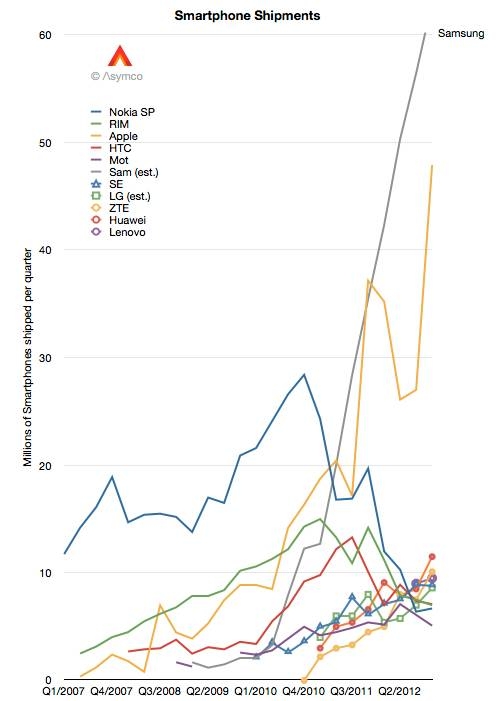
In an interview about the impact of Samsung's Galaxy S4 on Apple (AAPL), Anouch Seydtaghi, deputy economics editor for the Swiss newspaper Le Temps, asked Asymco's Horace Dediu what seemed like a perfectly reasonable question:
就三星(Samsung)Galaxy S4对苹果(Apple)造成的影响,瑞士报纸《时报》(Le Temps)财经版副主编阿诺和?赛德塔基采访了美国数据调查机构Asymco的贺拉斯?德迪乌,而且问了一个似乎非常合理的问题:
Q: Can Apple regain the lead in the smartphone market? If yes, how?
问:苹果能否夺回在智能手机市场的领先地位?怎样做才有可能?
Dediu responded, characteristically, with a chart:
秉承一贯风格,德迪乌用一幅图表给出了回答:
A: Apple had leadership in the phone market for two quarters (see graphic).
答:苹果曾领导手机市场两个季度(见图表)。
It's a myth to think that Apple was dominant for any extended period of time. The top spot is very difficult to obtain unless a company has a large portfolio of products which are sold in all markets. Apple has less than half the operator distribution of Samsung and keeps only one new product in the market each year.
认为苹果曾长期主导市场不过是错觉。除非某家公司的产品阵容庞大,而且在所有市场销售,否则要想登上头把交椅相当困难。苹果手机的运营商销售网络尚不足三星的一半,而且苹果每年仅推出一款新产品。
Apple also has a very high price due to the distribution model it uses for the iPhone. The primary buyers are operators who made large volume purchase commitments a few years ago. The iPhone strategy can be summarized as "skimming" where they pick the most profitable customers rather than "penetration" where there is a focus on market share. It's therefore very surprising that Apple was able to ship as many phones as it did.
此外,苹果采用的分销模式使得iPhone的价格极高。它的主要买家是几年前做出大批量购买承诺的运营商。iPhone的定价战略可概括为“撇脂法”,只瞄准最能带来盈利的客户,而不是注重市场占有率的“渗透法”。因此,苹果能有如今这样的出货量已经很令人惊讶了。


